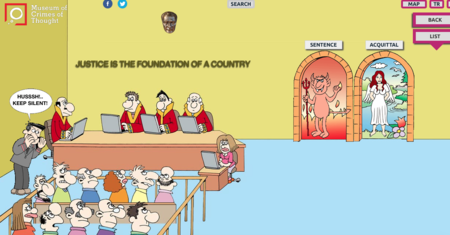The Turkish Museum of Crimes of Thought: Explaining Laws & Freedom to Netizens
The moment I step into court, a stern bailiff shushes me. Initially, the judges seem stately, almost sophisticated, but as I gaze at their silly red robes and blank facial expressions, it's hard not to chuckle. The court stenographer looks as if she's on a verge of a breakdown. The yellowish walls have a depressingly Soviet-like hue; they are mostly bare, though one wall has "JUSTICE IS THE FOUNDATION OF A COUNTRY" written on it. This could be almost any courtroom, I think. Except it isn't.

Screenshot from the Museum of Crimes of Thought.
This courtroom is one of the 80 rooms belonging to the Turkish Museum of Crimes of Thought, an innovative and exclusively virtual effort to inform netizens, from Istanbul to Indianapolis, Gaziantep to Jakarta, of Turkey's censoring mechanisms, laws, and penal system. The project employs a unique digital architecture. While the webpage can be accessed from Turkey, it's not housed on a Turkish server. Its founder, Şanar Yurdatapan, has promised to share the museum's blueprint, that is, its technical codebase, with any organization or individual.
From the outset, I was curious to know more about how "virtual" museums might differ from those that have clearly defined longitudes and latitudes, entrance fees, and coatrooms. For answers and insight, I turned to Raphaël Roig, Senior Programmes Officer at the International Council of Museums. Roig explained, "Though the international museum community agrees that a museum can host virtual collections, the issue of the 'materiality' of museums is the source of huge debates among the profession...the permanent dimension of a website is particularly complex, particularly with regards to curatorship, conservation, and storage – i.e. what happens to the collection when the website closes?"
Despite Turkey's history of Internet filtering, there's no evidence of Turkish Museum of Crimes of Thought closing anytime soon; in an email, Yurdatapan sent a list of the advantages inherent in using any inherently digital space:
1. No building, no permission, no bureaucracy, no strict state control.
2. No need for a huge investment.
3. No danger of being ruined by a Fascist group supported by police.
4. What you bring together will be there forever.
The Museum of Crimes of Thought provides a very specific interpretation of the Turkish legal and penal system. With its animations and explanatory signs, the Museum is intriguing; it's the sort of place where you could spend two minutes, two hours, or even two days. Other digital spaces - namely the Lebanese Virtual Museum of Censorship - have developed to track censored books, art, music, and translations, but few have tried to use an interactive, animated platform. Building the Turkish Museum didn't happen overnight; its team of architects started with FLASH but had to change it later, delaying the launch considerably. Despite the delays, Yurdatapan hopes his model will soon catch on and is working with IFEX to build an international network of similar virtual museums.
The truth is that digital museums aren't all that new. Elizabeth Merritt, founder of the Center for the Future of Museums, listed a few that she has visited in the past decade: the Smithsonian Latino Museum in Second Life, the Sackrider Museum of Handbags, the Museum of Advertising Icons, and the Museum of Motherhood. But, very few museums - virtual or otherwise - focus exclusively on legal systems, laws, and the idea of censorship. Google "censorship" and "museums," and you'll likely get a slew of blog posts and articles explaining how curators have censored controversial art.
As I prepare to leave, I step in front of a door marked "Rights," but when I knock, there is no response. While the Museum's design team has thought of including a room devoted to Internet bans and filtering, they are still working on the ground floor. I reached out to Yurdatapan to ask what might eventually lie in the "Rights" section, and this was his response: "[There will be] a corridor with many rooms on it. Each door will open to another basic right (i.e. right to live, work, assemble, demonstrate, etc.)."

Screenshot from the Museum of Crimes of Thought.
According to the current design, museumgoers will be blocked from entering any rights-related rooms, until they visit the "Freedom of Expression" hall. There, they'll be able to access a key to unlock all the other doors.
Ultimately, the Turkish Museum of Crimes of Thought is still only one corner of a constantly morphing virtual sphere. In recent years, the Turkish government has blocked and then unblocked various websites, including Twitter, Bitly, YouTube, and many other sites. With the recent election results changing the political texture of the Turkish Parliament, the jury is out on what sorts of Internet policies will emerge in the coming months.
Muira McCammon, a Berktern, is a former Fulbrighter, who spent 2013-2014 in Erzincan, Turkey.